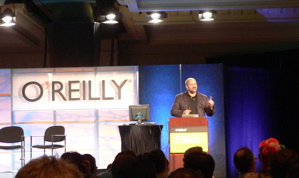Covering a lot of ground here this morning, in three wildly varying sessions. The first was Werner Vogels of Amazon giving a pitch on “Web-Scale Computing Architecture” provided by — what else? — his firm’s Amazon Web Services (AWS) platform. Nothing new here, as others have commented, but he had a couple of users on stage to give reports.  He cited a recent 37Signals book on how to do a Web 2.0 startup, which has a chapter entitled something like “Scale Later – Because It’s Really Hard.” That, of course, plays right into why you should let AWS worry about such things. “Focus on your idea,” said Werner, “and let our web-scale computing services meet infinite demand, cheaply and effectively.” A customer from RightScale.com, Thorsten von Eicken, said he’s been “running his service on Amazon for six months and will never go back.” Doug Kaye, CTO of Gigavox Media, said the service “has been big for us,” and that the price is right: his firm’s bill from Amazon for the first two months was only $84. “How great is that for a startup?”
He cited a recent 37Signals book on how to do a Web 2.0 startup, which has a chapter entitled something like “Scale Later – Because It’s Really Hard.” That, of course, plays right into why you should let AWS worry about such things. “Focus on your idea,” said Werner, “and let our web-scale computing services meet infinite demand, cheaply and effectively.” A customer from RightScale.com, Thorsten von Eicken, said he’s been “running his service on Amazon for six months and will never go back.” Doug Kaye, CTO of Gigavox Media, said the service “has been big for us,” and that the price is right: his firm’s bill from Amazon for the first two months was only $84. “How great is that for a startup?”
Jane McGonigal of Avant Game gave a fascinating talk on “Creating Alternate Realities.” She spoke of the three realms of happiness: pleasure, engagement, and meaning, and how the gaming industry can deal with these, even suggesting that making improved quality of life should be a priority.  “The new games are supergames,” she said. “They have massive scale, they are a superimposed hybrid experience, they’re super heroic, and they’re supercomputing.” What does all this have to do with the three realms of happiness? “They make you feel a part of something bigger, that you’re making meaning,” said McGonigal. Her talk closed with her ETech call to action: “Understanding and innovating happiness is the new capital. Hack happiness!” she said. And she told everyone to check out www.AvantGame.com/happiness. (I hope that link works for you, because it doesn’t for me yet.)
“The new games are supergames,” she said. “They have massive scale, they are a superimposed hybrid experience, they’re super heroic, and they’re supercomputing.” What does all this have to do with the three realms of happiness? “They make you feel a part of something bigger, that you’re making meaning,” said McGonigal. Her talk closed with her ETech call to action: “Understanding and innovating happiness is the new capital. Hack happiness!” she said. And she told everyone to check out www.AvantGame.com/happiness. (I hope that link works for you, because it doesn’t for me yet.)
The last big presentation of the morning was by Jeff Hawkins, cofounder of Numenta, and late of Palm and Handspring fame. His latest company is about neuroscience and traces back to a book he wrote a couple of years ago, “On Intelligence.”  A new friend I just met, Alex Iskold, wrote a post about Numenta this morning on Read/Write Web, which I discovered about 7:00 am when I went online in the hotel lobby. (And I see it’s already been Dugg about 500 times.) Hawkins said there’s no computer today that you can ask, “What is this picture?” But he’s working on that problem of visual perception, as well as a number of others, with a platform that’s based on a theory of how the neocortex works — Hierarchial Temporal Memory. The platform is called NuPIC, and, said Hawkins, “It works. We already have several customers.” He stated that the technology is especially of interest to companies in industries such as automotive, gaming, network modeling, drug discovery, vision systems, market analysis, and business modeling. The future? He said likely uses will be in music, language, and robotics.
A new friend I just met, Alex Iskold, wrote a post about Numenta this morning on Read/Write Web, which I discovered about 7:00 am when I went online in the hotel lobby. (And I see it’s already been Dugg about 500 times.) Hawkins said there’s no computer today that you can ask, “What is this picture?” But he’s working on that problem of visual perception, as well as a number of others, with a platform that’s based on a theory of how the neocortex works — Hierarchial Temporal Memory. The platform is called NuPIC, and, said Hawkins, “It works. We already have several customers.” He stated that the technology is especially of interest to companies in industries such as automotive, gaming, network modeling, drug discovery, vision systems, market analysis, and business modeling. The future? He said likely uses will be in music, language, and robotics.
Update: To add tags below.
 Webb asked the question, “How do we design for this generation?” Though he’s a product designer himself, he went on to say later that Generation C is capable of building products of their own, being so into social networks and mashups and things — so one wonders then why we need product designers? But that’s just the pixel side of the equation. We still need people with design sense to help us sculpt things made out atoms — plastic or whatever. Products are getting smarter and more social, with all kinds of networking capabilities, of course. And we have “new paradigms for interaction,” said Webb. He cited widgets, for example, which he said is such a great paradigm, “it shouldn’t be limited to just the desktop and web.” A key point Webb made is that experience is what counts to this generation, and “how do we design for experience?” He said in his wrapup that experience should be “treated as a design surface,” and that all of us in the room are the right people to address these new design challenges. One nice thing the O’Reilly people pointed out to us in the description of this session was that “people have been paying for plastic longer than pixels.” So, the business model is there! 🙂 It should be an exciting future for product designers, whoever they may be.
Webb asked the question, “How do we design for this generation?” Though he’s a product designer himself, he went on to say later that Generation C is capable of building products of their own, being so into social networks and mashups and things — so one wonders then why we need product designers? But that’s just the pixel side of the equation. We still need people with design sense to help us sculpt things made out atoms — plastic or whatever. Products are getting smarter and more social, with all kinds of networking capabilities, of course. And we have “new paradigms for interaction,” said Webb. He cited widgets, for example, which he said is such a great paradigm, “it shouldn’t be limited to just the desktop and web.” A key point Webb made is that experience is what counts to this generation, and “how do we design for experience?” He said in his wrapup that experience should be “treated as a design surface,” and that all of us in the room are the right people to address these new design challenges. One nice thing the O’Reilly people pointed out to us in the description of this session was that “people have been paying for plastic longer than pixels.” So, the business model is there! 🙂 It should be an exciting future for product designers, whoever they may be. Similarly, games are made up of games — lots of little ones are in any good game, he said. Building games is about good “interaction design.” Then he ran us through a quick lesson in designing for fun, or applying game design to, for example, social media applications. He said you should have statistical features and opportunities for competition. “Never start an interaction with no context,” he said. And the participant must be able to prepare for the next encounter. Users should be able to solve challenges with a choice of tools, he said. “Reward them with different feedback. Variable feedback keeps things lively. And it should be visible to everyone.” Raph closed by telling us to check out his book site for more:
Similarly, games are made up of games — lots of little ones are in any good game, he said. Building games is about good “interaction design.” Then he ran us through a quick lesson in designing for fun, or applying game design to, for example, social media applications. He said you should have statistical features and opportunities for competition. “Never start an interaction with no context,” he said. And the participant must be able to prepare for the next encounter. Users should be able to solve challenges with a choice of tools, he said. “Reward them with different feedback. Variable feedback keeps things lively. And it should be visible to everyone.” Raph closed by telling us to check out his book site for more:  Magic is a good metaphor, “a useful abstraction … because it does not cripple — it explains.” Magic to him is about the interaction you have with an object.
Magic is a good metaphor, “a useful abstraction … because it does not cripple — it explains.” Magic to him is about the interaction you have with an object.  He cited a recent 37Signals book on how to do a Web 2.0 startup, which has a chapter entitled something like “Scale Later – Because It’s Really Hard.” That, of course, plays right into why you should let AWS worry about such things. “Focus on your idea,” said Werner, “and let our web-scale computing services meet infinite demand, cheaply and effectively.” A customer from RightScale.com, Thorsten von Eicken, said he’s been “running his service on Amazon for six months and will never go back.” Doug Kaye, CTO of Gigavox Media, said the service “has been big for us,” and that the price is right: his firm’s bill from Amazon for the first two months was only $84. “How great is that for a startup?”
He cited a recent 37Signals book on how to do a Web 2.0 startup, which has a chapter entitled something like “Scale Later – Because It’s Really Hard.” That, of course, plays right into why you should let AWS worry about such things. “Focus on your idea,” said Werner, “and let our web-scale computing services meet infinite demand, cheaply and effectively.” A customer from RightScale.com, Thorsten von Eicken, said he’s been “running his service on Amazon for six months and will never go back.” Doug Kaye, CTO of Gigavox Media, said the service “has been big for us,” and that the price is right: his firm’s bill from Amazon for the first two months was only $84. “How great is that for a startup?” “The new games are supergames,” she said. “They have massive scale, they are a superimposed hybrid experience, they’re super heroic, and they’re supercomputing.” What does all this have to do with the three realms of happiness? “They make you feel a part of something bigger, that you’re making meaning,” said McGonigal. Her talk closed with her ETech call to action: “Understanding and innovating happiness is the new capital. Hack happiness!” she said. And she told everyone to check out
“The new games are supergames,” she said. “They have massive scale, they are a superimposed hybrid experience, they’re super heroic, and they’re supercomputing.” What does all this have to do with the three realms of happiness? “They make you feel a part of something bigger, that you’re making meaning,” said McGonigal. Her talk closed with her ETech call to action: “Understanding and innovating happiness is the new capital. Hack happiness!” she said. And she told everyone to check out  A new friend I just met, Alex Iskold, wrote a post about Numenta this morning on
A new friend I just met, Alex Iskold, wrote a post about Numenta this morning on 
Recent Comments